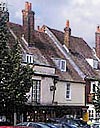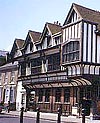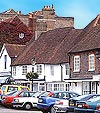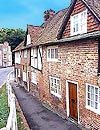![]() Norman New Towns in England
Norman New Towns in England
Norman New Towns ![]() New Towns in Hampshire
New Towns in Hampshire

![Aerial view of Ludlow Castle and market place. [English Heritage]](4/ludcas1th.jpg) The
urban geography of many parts of England was radically changed between the Norman Conquest
and the mid 13th century by the foundation of several hundred new towns or
enlargement of existing villages. These were places given a charter from the
king, a leading baron, bishop or monastic house which conferred on them the
legal status of a borough. Privileges were granted to the leading citizens,
or burgesses, largely relating to the right to hold markets and levy tolls.
The citizens might also be allowed to collect their own taxes and pass them
directly to the crown without the lord's interference. At the same time a
town's founder was able to raise much more rent from his wealthy urban tenants
than from those on his rural manors.
The
urban geography of many parts of England was radically changed between the Norman Conquest
and the mid 13th century by the foundation of several hundred new towns or
enlargement of existing villages. These were places given a charter from the
king, a leading baron, bishop or monastic house which conferred on them the
legal status of a borough. Privileges were granted to the leading citizens,
or burgesses, largely relating to the right to hold markets and levy tolls.
The citizens might also be allowed to collect their own taxes and pass them
directly to the crown without the lord's interference. At the same time a
town's founder was able to raise much more rent from his wealthy urban tenants
than from those on his rural manors.
 New
towns were usually laid out to promote economic activity with a central market
place in the form of square or a long, broad street. Individual building plots
were long and narrow, and set end-on to the street so as to give as many residents
as possible access to the frontage where each house would have a shop. The
plots were let for money rents rather than rents in kind.
New
towns were usually laid out to promote economic activity with a central market
place in the form of square or a long, broad street. Individual building plots
were long and narrow, and set end-on to the street so as to give as many residents
as possible access to the frontage where each house would have a shop. The
plots were let for money rents rather than rents in kind.
Many new towns were located outside gates of their lord's castle (e.g. Windsor and Ludlow) or abbey (St Albans), thereby providing customers for the town market. Some foundations were immediately successful and, as at Ludlow, were enlarged by means of a simple grid of streets attached to the original market place. Not all new towns flourished, however, and in the Welsh border, for example, there were numerous failed boroughs which never became more than villages.

 One
of the earliest may have been the port of Southampton. Its link with Normandy
was of great importance following the Conquest. An influx of Norman settlers
probably resulted in the deliberate planning of the area around St Michael's
Square and French Street. By the 12th century Portsmouth had also developed
around its harbour mouth and in 1194 was granted a charter by Richard I. It
is highly likely that three parallel and crossstreets
with burgage plots were introduced at this time.
One
of the earliest may have been the port of Southampton. Its link with Normandy
was of great importance following the Conquest. An influx of Norman settlers
probably resulted in the deliberate planning of the area around St Michael's
Square and French Street. By the 12th century Portsmouth had also developed
around its harbour mouth and in 1194 was granted a charter by Richard I. It
is highly likely that three parallel and crossstreets
with burgage plots were introduced at this time.

 The building of a bishop's residence
at Bishop's Waltham would have encouraged the development of a settlement
close by. Archaeological evidence suggests earlier Saxon occupation, backed
up by the presence of a minster church. This would probably have been re-planned
in the 12th century with the market place and a gridded layout of streets
that we
see today. Another ecclesiastical development can be seen at New Alresford,
founded by Bishop de Lucy in 1200, consisting of one wide street running north-south
and appropriately called Broad Street.
The building of a bishop's residence
at Bishop's Waltham would have encouraged the development of a settlement
close by. Archaeological evidence suggests earlier Saxon occupation, backed
up by the presence of a minster church. This would probably have been re-planned
in the 12th century with the market place and a gridded layout of streets
that we
see today. Another ecclesiastical development can be seen at New Alresford,
founded by Bishop de Lucy in 1200, consisting of one wide street running north-south
and appropriately called Broad Street.

 The
town of Wickham is a delight. There was probably a village here long before
it was granted a charter for a market and fair in 1268. It has a large square,
surrounded by pretty houses, shops, and inns. Many of the medieval houses
now have Georgian facades reflecting the desire to copy the elite classical
houses of the time. Fortunately, behind these facades many unspoilt medieval
timber framed buildings can be seen, with their high pitched and irregular
roof lines betraying a much earlier past.
The
town of Wickham is a delight. There was probably a village here long before
it was granted a charter for a market and fair in 1268. It has a large square,
surrounded by pretty houses, shops, and inns. Many of the medieval houses
now have Georgian facades reflecting the desire to copy the elite classical
houses of the time. Fortunately, behind these facades many unspoilt medieval
timber framed buildings can be seen, with their high pitched and irregular
roof lines betraying a much earlier past.